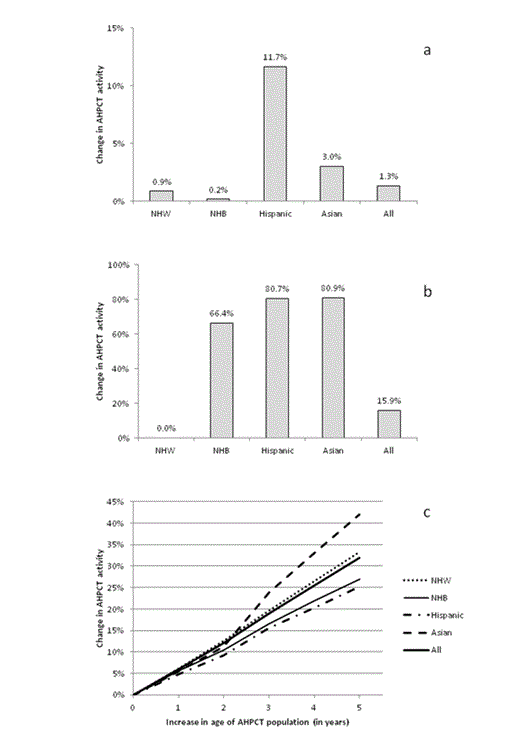Abstract
Introduction: Autologous hematopoietic progenitor cell transplantation (AHPCT) is an established modality in the treatment of patients with multiple myeloma (MM) with impact in depth and duration of remission and, in some studies, overall survival. Utilization of AHPCT for treatment of MM in US is increasing but still low. Race-ethnicity, sex and age-disparities may affect AHPCT utilization, although they do not impact benefit from AHPCT.
Methods: MM incidence derived from Surveillance, Epidemiology and End Results (SEER-18) database and AHPCT for MM reported to the Center for International Blood and Marrow Transplant Research (CIBMTR) between 2005-2009 were analyzed. Cases were grouped in 4 racial-ethnic categories (REC): non-Hispanic Whites (NHW), non-Hispanic Blacks (NHB), Hispanics (irrespective of race) and Asians. We assessed utilization as the ratio between first AHPCT for MM and number of newly diagnosed cases in the period of interest and calculated the relative utilization ratio (RUR), as [utilization for a given category] / [utilization for the entire population].
Results: Data was obtained from 22,462 actual MM cases reported to SEER and 13,311 actual AHPCT reported to CIBMTR. NHW, NHB, Hispanics and Asians corresponded respectively to 72.0%, 18.7%, 6.7% and 2.6% of the new MM cases and 77.4%, 15.85, 5.2% and 1.6% of the AHPCT procedures. Median age at diagnosis of MM was higher in NHW (P=0.0002)and was higher in women than in men in all RECs. Age-adjusted RUR was 1.17 (95% C.I. 1.15-1.19) among NHW, higher than in NHB [0.69 (95% C.I. 0.67-0.72), P<0.0002], Hispanics [0.64 (95% C.I. 0.60-0.69), p<0.002] and Asians [0.65 (95% C.I. 0.58-0.73), P<0.0002]. There was higher utilization of AHPCT in men than in women detected among Hispanics (age adjusted RUR 0.72 vs 0.56, P=0.007), but not among NHW, NHB or Asians. Only 3.1% of the NHW patients younger than 65 were identified as uninsured vs. 8.1% of NHB, 11.9% of Hispanics and 3.2% of Asians (P<0.0001). Correction of sex disparity would lead to an overall increase of 1.3% in AHPCT for MM, higher among Hispanics (11.7%) but lower in the other categories (Figure, panel a). The hypothetical correction of racial-ethnic disparity would result in 15.9% increase in volume of AHPCT, with a pronounced increase among NHB, Hispanics and Asians (Figure, panel b). Increase in age at transplant will strongly affect AHPCT volumes with dissimilar impact in different RECs according to their age structure (Figure, panel c).
Conclusions: Race-ethnicity disparity greatly affects AHPCT utilization for management of MM in US. Sex disparity plays a much lesser role, except among Hispanics. The profound age disparity is decreasing over time and will likely continue to drive major increase of AHPCT activity.
No relevant conflicts of interest to declare.
Author notes
Asterisk with author names denotes non-ASH members.


This feature is available to Subscribers Only
Sign In or Create an Account Close Modal